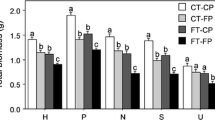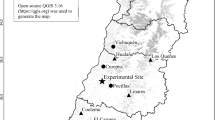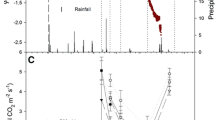Abstract
In anticipation of more severe summer droughts, forestry in temperate Europe is searching for drought-resistant ecotypes of native tree species that might maintain ecosystem services in the future. We investigated how spring precipitation and soil conditions interact with summer drought and affect the establishment of conifer seedlings from different climatic origin. Emergence, establishment and subsequent performance of seedlings originating from autochthonous, Central Alpine, continental Eastern European, and Mediterranean Pinus sylvestris and Picea abies populations were studied in the dry Alpine Rhine valley, Switzerland, at three sites with differing soil water holding capacities and in 3 years with contrasting weather conditions. In addition to this natural inter-annual variation, precipitation was manipulated within sites with throughfall reduction roofs. Seedling establishment and growth were principally affected by the spring weather in the year of emergence. In years with average to positive spring water balance, seedlings grown at the site with the highest water holding capacity had 2–5 times more aboveground biomass than seedlings grown at sites with less favourable soils. Effects of seed origin were marginal and only detectable at the drier sites: contrary to our expectations, seedlings from the Central Alpine Rhone valley, where the climatic spring water deficit is large, outperformed those from the Mediterranean. Consequently, plantation of non-native populations from dryer origin will mitigate the effects of increased summer drought at driest sites only, while the inter-annual variability of spring precipitation will continue to enable temperate conifers to regenerate on a wide range of forest soils independent of seed origin.




Similar content being viewed by others
References
Aitken SN, Yeaman S, Holliday JA, Wang TL, Curtis-McLane S (2008) Adaptation, migration or extirpation: climate change outcomes for tree populations. Evol Appl 1:95–111. doi:10.1111/j.1752-4571.2007.00013.x
Bigler C, Bräker OU, Bugmann H, Dobbertin M, Rigling A (2006) Drought as an inciting mortality factor in Scots pine stands of the Valais, Switzerland. Ecosystems 9:330–343. doi:10.1007/s10021-005-0126-2
Bussotti F, Pollastrini M, Holland V, Bruggemann W (2015) Functional traits and adaptive capacity of European forests to climate change. Environ Exp Bot 111:91–113. doi:10.1016/j.envexpbot.2014.11.006
Carnicer J, Coll M, Ninyerola M, Pons X, Sánchez G, Peñuelas J (2011) Widespread crown condition decline, food web disruption, and amplified tree mortality with increased climate change-type drought. Proc Natl Acad Sci USA 108:1474–1478. doi:10.1073/pnas.1010070108
Castro J (2006) Short delay in timing of emergence determines establishment success in Pinus sylvestris across microhabitats. Ann Bot 98:1233–1240. doi:10.1093/aob/mcl208
Castro J, Zamora R, Hódar JA, Gómez JM (2004) Seedling establishment of a boreal tree species (Pinus sylvestris) at its southernmost distribution limit: consequences of being in a marginal Mediterranean habitat. J Ecol 92:266–277. doi:10.1111/j.0022-0477.2004.00870.x
CH2011 (2011) Swiss climate change scenarios CH2011. C2SM, MeteoSwiss, ETH, NCCR Climate, and OcCC, Zürich
Costa JM, Grant OM, Chaves MM (2013) Thermography to explore plant–environment interactions. J Exp Bot 64:3937–3949. doi:10.1093/jxb/ert029
Dobrowski SZ, Swanson AK, Abatzoglou JT, Holden ZA, Safford HD, Schwartz MK, Gavin DG (2015) Forest structure and species traits mediate projected recruitment declines in western US tree species. Glob Ecol Biogeogr 24:917–927. doi:10.1111/geb.12302
Eilmann B, Buchmann N, Siegwolf R, Saurer M, Cherubini P, Rigling A (2010) Fast response of Scots pine to improved water availability reflected in tree-ring width and delta 13C. Plant Cell Environ 33:1351–1360. doi:10.1111/j.1365-3040.2010.02153.x
Ellenberg H (1988) Vegetation ecology of Central Europe. Cambridge University Press, Cambridge
Fischer AM, Keller DE, Liniger MA, Rajczak J, Schär C, Appenzeller C (2015) Projected changes in precipitation intensity and frequency in Switzerland: a multi-model perspective. Int J Climatol 35:3204–3219. doi:10.1002/joc.4162
Fridley JD, Wright JP (2012) Drivers of secondary succession rates across temperate latitudes of the Eastern USA: climate, soils, and species pools. Oecologia 168:1069–1077. doi:10.1007/s00442-011-2152-4
Fridley JD, Grime JP, Askew AP, Moser B, Stevens CJ (2011) Soil heterogeneity buffers community response to climate change in species-rich grassland. Global Change Biol 17:2001–2011. doi:10.1111/j.1365-2486.2010.02347.x
García-Palacios P, Maestre FT, Bardgett RD, de Kroon H (2012) Plant responses to soil heterogeneity and global environmental change. J Ecol 100:1303–1314. doi:10.1111/j.1365-2745.2012.02014.x
Gimmi U, Wohlgemuth T, Rigling A, Hoffmann CW, Bürgi M (2010) Land-use and climate change effects in forest compositional trajectories in a dry Central-Alpine valley. Ann Forest Sci 67:701. doi:10.1051/forest/2010026
Giuggiola A, Bugmann H, Zingg A, Dobbertin M, Rigling A (2013) Reduction of stand density increases drought resistance in xeric Scots pine forests. Forest Ecol Manag 310:827–835. doi:10.1016/j.foreco.2013.09.030
Grubb PJ (1977) Maintenance of species-richness in plant communities—importance of regeneration niche. Biol Rev Camb Philos Soc 52:107–145. doi:10.1111/j.1469-185X.1977.tb01347.x
Hanewinkel M, Hummel S, Cullmann DA (2010) Modelling and economic evaluation of forest biome shifts under climate change in Southwest Germany. Forest Ecol Manag 259:710–719. doi:10.1016/j.foreco.2009.08.021
Hanewinkel M, Cullmann DA, Schelhaas M, Nabuurs G, Zimmermann NE (2013) Climate change may cause severe loss in the economic value of European forest land. Nat Clim Change 3:203–207. doi:10.1038/nclimate1687
Hawkins E, Sutton R (2011) The potential to narrow uncertainty in projections of regional precipitation change. Clim Dyn 37:407–418. doi:10.1007/s00382-010-0810-6
Hereş AM, Camarero JJ, López BC, Martínez-Vilalta J (2014) Declining hydraulic performances and low carbon investments in tree rings predate Scots pine drought-induced mortality. Trees Struct Funct 28:1737–1750. doi:10.1007/s00468-014-1081-3
Ibàñez I, Clark JS, Dietze MC (2009) Estimating colonization potential of migrant tree species. Global Change Biol 15:1173–1188. doi:10.1111/j.1365-2486.2008.01777.x
Kapeller S, Lexer MJ, Geburek T, Hiebl J, Schüler S (2012) Intraspecific variation in climate response of Norway spruce in the eastern Alpine range: selecting appropriate provenances for future climate. Forest Ecol Manag 271:46–57. doi:10.1016/j.foreco.2012.01.039
Laube J, Sparks TH, Estrella N, Hoefler J, Ankerst DP, Menzel A (2014) Chilling outweighs photoperiod in preventing precocious spring development. Global Change Biol 20:170–182. doi:10.1111/gcb.12360
Lenoir J, Graae BJ, Aarrestad PA, Alsos IG, Armbruster WS, Austrheim G, Bergendorff C, Birks HJB, Bråthen KA, Brunet J, Bruun HH, Dahlberg CJ, Decocq G, Diekmann M, Dynesius M, Ejrnaes R, Grytnes JA, Hylander K, Klanderud K, Luoto M, Milbau A, Moora M, Nygaard B, Odland A, Ravolainen VT, Reinhardt S, Sandvik SM, Schei FH, Speed JDM, Tveraabak LU, Vandvik V, Velle LG, Virtanen R, Zobel M, Svenning JC (2013) Local temperatures inferred from plant communities suggest strong spatial buffering of climate warming across Northern Europe. Global Change Biol 19:1470–1481. doi:10.1111/gcb.12129
Leuzinger S, Luo YQ, Beier C, Dieleman W, Vicca S, Körner C (2011) Do global change experiments overestimate impacts on terrestrial ecosystems? Trends Ecol Evol 26:236–241. doi:10.1016/j.tree.2011.02.011
Lévesque M, Rigling A, Bugmann H, Weber P, Brang P (2014) Growth response of five co-occurring conifers to drought across a wide climatic gradient in Central Europe. Agric Forest Meteorol 197:1–12. doi:10.1016/j.agrformet.2014.06.001
Lindner M, Fitzgerald JB, Zimmermann NE, Reyer C, Delzon S, van der Maaten E, Schelhaas M-J, Lasch P, Eggers J, van der Maaten-Theunissen M, Suckow F, Psomas A, Poulter B, Hanewinkel M (2014) Climate change and European forests: what do we know, what are the uncertainties, and what are the implications for forest management? J Environ Manag 146:69–83. doi:10.1016/j.jenvman.2014.07.030
Lischke H, Zimmermann NE, Bolliger J, Rickebusch S, Löffler TJ (2006) TreeMig: a forest-landscape model for simulating spatio-temporal patterns from stand to landscape scale. Ecol Model 199:409–420. doi:10.1016/j.ecolmodel.2005.11.046
Mátyás C, Ackzell L, Samuel CJA (2003) EUFORGEN Technical guidelines for genetic conservation and use for Scots pine (Pinus sylvestris). International Plant Genetic Resources Institute, Rome
Modrzyński J, Eriksson G (2002) Response of Picea abies populations from elevational transects in the Polish Sudety and Carpathian mountains to simulated drought stress. Forest Ecol Manag 165:105–116. doi:10.1016/S0378-1127(01)00651-X
Moser B, Temperli C, Schneiter G, Wohlgemuth T (2010) Potential shift in tree species composition after interaction of fire and drought in the Central Alps. Eur J Forest Res 129:625–633. doi:10.1007/s10342-010-0363-6
Moser B, Metslaid M, Walthert L, Wasem U, Wohlgemuth T (2015) Verjüngungspotenzial verschiedener Waldföhren- und Fichtenherkünfte bei variabler Trockenheit. Schweiz Z Forstwes 166:399–407. doi:10.3188/szf.2015.0399
Nussbaumer A, Waldner P, Etzold S, Gessler A, Benham S, Thomsen IM, Jørgensen BB, Timmermann V, Verstraeten A, Soen G, Rautio P, Ukonmaanaho L, Skudnik M, Apuhtin V, Braun S, Wauer A (2016) Patterns of mast fruiting of common beech, sessile and common oak, Norway spruce and Scots pine in Central and Northern Europe. Forest Ecol Manag 363:237–251. doi:10.1016/j.foreco.2015.12.033
Piper FI, Fajardo A, Cavieres LA (2013) Simulated warming does not impair seedling survival and growth of Nothofagus pumilio in the southern Andes. Perspect Plant Ecol Evol Syst 15:97–105. doi:10.1016/j.ppees.2013.02.003
R Core Team (2015) R: a language and environment for statistical computing. R Foundation for Statistical Computing, Vienna
Reinert S, Bögelein R, Thomas FM (2012) Use of thermal imaging to determine leaf conductance along a canopy gradient in European beech (Fagus sylvatica). Tree Physiol 32:294–302. doi:10.1093/treephys/tps017
Renwick KM, Rocca ME (2015) Temporal context affects the observed rate of climate-driven range shifts in tree species. Global Ecol Biogeogr 24:44–51. doi:10.1111/geb.12240
Richter S, Kipfer T, Wohlgemuth T, Guerrero C, Ghazoul J, Moser B (2012) Phenotypic plasticity facilitates resistance to climate change in a highly variable environment. Oecologia 169:269–279. doi:10.1007/s00442-011-2191-x
Rigling A, Bigler C, Eilmann B, Feldmeyer-Christe E, Gimmi U, Ginzler C, Graf U, Mayer P, Vacchiano G, Weber P, Wohlgemuth T, Zweifel R, Dobbertin M (2013) Driving factors of a vegetation shift from Scots pine to pubescent oak in dry Alpine forests. Global Change Biol 19:229–240. doi:10.1111/gcb.12038
Sánchez-Gómez D, Robson TM, Gascó A, Gil-Pelegrín E, Aranda I (2013) Differences in the leaf functional traits of six beech (Fagus sylvatica L.) populations are reflected in their response to water limitation. Environ Exp Bot 87:110–119. doi:10.1016/j.envexpbot.2012.09.011
Savage M, Brown PM, Feddema J (1996) The role of climate in a pine forest regeneration pulse in the southwestern United States. Ecoscience 3:310–318
Scherrer D, Körner C (2011) Topographically controlled thermal-habitat differentiation buffers alpine plant diversity against climate warming. J Biogeogr 38:406–416. doi:10.1111/j.1365-2699.2010.02407.x
Scherrer D, Bader MKF, Körner C (2011) Drought-sensitivity ranking of deciduous tree species based on thermal imaging of forest canopies. Agric Forest Meteorol 151:1632–1640. doi:10.1016/j.agrformet.2011.06.019
Schleppi P, Bucher-Wallin I, Hagedorn F, Körner C (2012) Increased nitrate availability in the soil of a mixed mature temperate forest subjected to elevated CO2 concentration (canopy FACE). Global Change Biol 18:757–768. doi:10.1111/j.1365-2486.2011.02559.x
Skrøppa T (2003) EUFORGEN technical guidelines for genetic conservation and use for Norway spruce (Picea abies). International Plant Genetic Resources Institute, Rome
Slavich E, Warton DI, Ashcroft MB, Gollan JR, Ramp D (2014) Topoclimate versus macroclimate: how does climate mapping methodology affect species distribution models and climate change projections? Divers Distrib 20:952–963. doi:10.1111/ddi.12216
Swidrak I, Gruber A, Oberhuber W (2014) Xylem and phloem phenology in co-occurring conifers exposed to drought. Trees Struct Funct 28:1161–1171. doi:10.1007/s00468-014-1026-x
Taeger S, Fussi B, Konnert M, Menzel A (2013) Large-scale genetic structure and drought-induced effects on European Scots pine (Pinus sylvestris L.) seedlings. Eur J Forest Res 132:481–496. doi:10.1007/s10342-013-0689-y
Teepe R, Dilling H, Beese F (2003) Estimating water retention curves of forest soils from soil texture and bulk density. J Plant Nutr Soil Sci 166:111–119. doi:10.1002/jpln.200390001
Thiel D, Kreyling J, Backhaus S, Beierkuhnlein C, Buhk C, Egen K, Huber G, Konnert M, Nagy L, Jentsch A (2014) Different reactions of central and marginal provenances of Fagus sylvatica to experimental drought. Eur J Forest Res 133:247–260. doi:10.1007/s10342-013-0750-x
Thornthwaite CW (1948) An approach toward a rational classification of climate. Geogr Rev 38:55–94
Thuiller W, Lavorel S, Sykes MT, Araujo MB (2006) Using niche-based modelling to assess the impact of climate change on tree functional diversity in Europe. Divers Distrib 12:49–60. doi:10.1111/j.1366-9516.2006.00216.x
von Arx G, Pannatier EG, Thimonier A, Rebetez M (2013) Microclimate in forests with varying leaf area index and soil moisture: potential implications for seedling establishment in a changing climate. J Ecol 101:1201–1213. doi:10.1111/1365-2745.12121
Walthert L, Zimmermann S, Blaser P, Luster J, Lüscher P (2004) Waldböden der Schweiz. Grundlagen und Region Jura, vol 1. Hep Verlag, Bern
Zackrisson O, Nilsson MC, Steijlen I, Hörnberg G (1995) Regeneration pulses and climate-vegetation interactions in nonpyrogenic boreal Scots pine stands. J Ecol 83:469–483. doi:10.2307/2261600
Acknowledgements
We are grateful to E. Schnider and A. Walter for their invaluable help in setting up and running the experiment. We also acknowledge the field and laboratory work of C. Bachofen, H. Bachofen, C. Baumann, H. Ding, R. Köchli, K. Kramer, S. Kreuzer, Z. Michalova, J. Müller, T. Reich, S. Steinböck, D. Trummer, and E. Wilson. Seed collection was organised and assisted by S. Berdos, C. Calderón Guerrero, G. Golesch, B. Kinigadner, I. Latchev, A. Tashev und N. Tashev. Climate data were provided by MeteoSwiss, the Swiss Federal Office of Meteorology and Climatology.
Author contribution statement
TW and BM conceived and designed the experiment. BM, TW, MM, UW, and LW conducted the fieldwork. BM analysed the data, LW collaborated in soil analysis. BM wrote the manuscript with editorial advice from other authors.
Author information
Authors and Affiliations
Corresponding author
Ethics declarations
Funding
The project was funded by the BAFU/WSL initiative “Wald und Klimawandel” and the Amt für Wald und Naturgefahren des Kantons Graubünden. MM is supported by grant IUT21-4 of the Estonian Ministry of Education and Research.
Conflict of interest
The authors declare that they have no conflict of interest.
Additional information
Communicated by Russell K. Monson.
Electronic supplementary material
Below is the link to the electronic supplementary material.
Rights and permissions
About this article
Cite this article
Moser, B., Walthert, L., Metslaid, M. et al. Spring water deficit and soil conditions matter more than seed origin and summer drought for the establishment of temperate conifers. Oecologia 183, 519–530 (2017). https://doi.org/10.1007/s00442-016-3766-3
Received:
Accepted:
Published:
Issue Date:
DOI: https://doi.org/10.1007/s00442-016-3766-3




